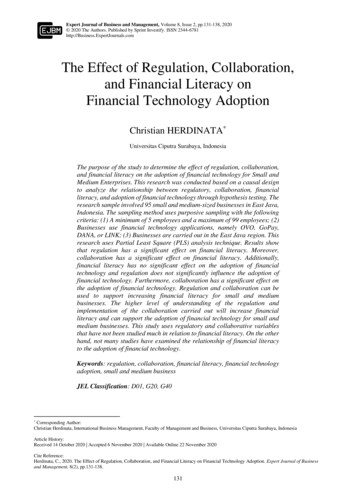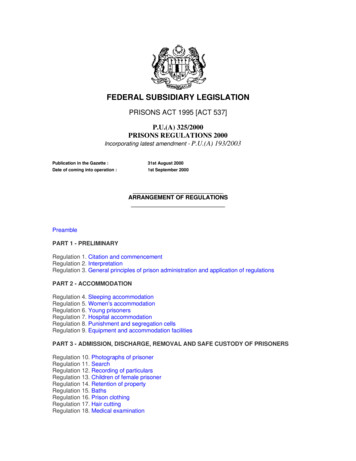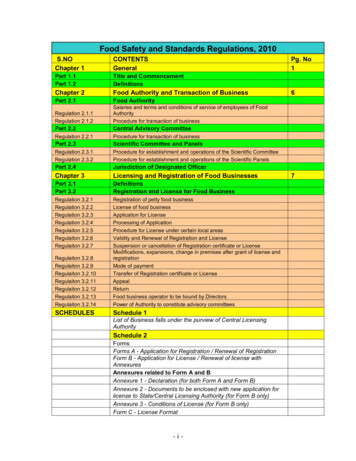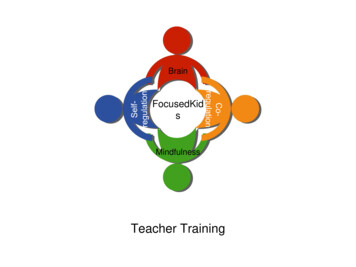
Transcription
Expert Journal of Business and Management, Volume 8, Issue 2, pp.131-138, 2020 2020 The Authors. Published by Sprint Investify. ISSN 2344-6781http://Business.ExpertJournals.comThe Effect of Regulation, Collaboration,and Financial Literacy onFinancial Technology AdoptionChristian HERDINATA*Universitas Ciputra Surabaya, IndonesiaThe purpose of the study to determine the effect of regulation, collaboration,and financial literacy on the adoption of financial technology for Small andMedium Enterprises. This research was conducted based on a causal designto analyze the relationship between regulatory, collaboration, financialliteracy, and adoption of financial technology through hypothesis testing. Theresearch sample involved 95 small and medium-sized businesses in East Java,Indonesia. The sampling method uses purposive sampling with the followingcriteria: (1) A minimum of 5 employees and a maximum of 99 employees; (2)Businesses use financial technology applications, namely OVO, GoPay,DANA, or LINK; (3) Businesses are carried out in the East Java region. Thisresearch uses Partial Least Square (PLS) analysis technique. Results showthat regulation has a significant effect on financial literacy. Moreover,collaboration has a significant effect on financial literacy. Additionally,financial literacy has no significant effect on the adoption of financialtechnology and regulation does not significantly influence the adoption offinancial technology. Furthermore, collaboration has a significant effect onthe adoption of financial technology. Regulation and collaboration can beused to support increasing financial literacy for small and mediumbusinesses. The higher level of understanding of the regulation andimplementation of the collaboration carried out will increase financialliteracy and can support the adoption of financial technology for small andmedium businesses. This study uses regulatory and collaborative variablesthat have not been studied much in relation to financial literacy. On the otherhand, not many studies have examined the relationship of financial literacyto the adoption of financial technology.Keywords: regulation, collaboration, financial literacy, financial technologyadoption, small and medium businessJEL Classification: D01, G20, G40*Corresponding Author:Christian Herdinata, International Business Management, Faculty of Management and Business, Universitas Ciputra Surabaya, IndonesiaArticle History:Received 14 October 2020 Accepted 6 November 2020 Available Online 22 November 2020Cite Reference:Herdinata, C., 2020. The Effect of Regulation, Collaboration, and Financial Literacy on Financial Technology Adoption. Expert Journal of Businessand Management, 8(2), pp.131-138.131
Herdinata, C., 2020. The Effect of Regulation, Collaboration, and Financial Literacy on Financial Technology Adoption.Expert Journal of Business and Management, 8(2), pp.131-138.1. IntroductionThe increasing financial literacy of the people of Indonesia, the long-term investment and placementof capital in various productive sectors will increase. Three development priorities can be driven by the use offinancial technology. First, capital mobilization increases the economic activity of underserved groups, suchas Low-Income Communities and Small and Medium Enterprises (SMEs). Second, mobilizing money tofinance basic infrastructure, such as sanitation and electricity. Third, mobilization of funds to encouragesustainable infrastructure development, such as clean energy, and or finance important innovations in thecontext of increasing agricultural and fisheries production. At present the SMEs have adapted to the 4.0industrial revolution that is happening. The most dominant thing is seen through financial technology used bySMEs. Therefore, financial technology can be a solution as revealed by Arner et al. (2015) that financialtechnology is broadly the technology used to deliver financial solutions. Another interesting thing is thatfinancial technology can cause disruptive innovation if it is not well anticipated by the business world whichcan cause a collapse. Therefore, the use of financial technology is proven to be able to provide greater accessto formal financial services, encourage economic growth, and inclusive and sustainable development. Thechallenge for Indonesia is to make the process of development and public service adaptive to the developmentof financial technology. (Chinen and Endo, 2012) state that individuals who have the ability to make the rightfinancial decisions will not have financial problems in the future and that proves sound financial behavior andis able to determine the priority scale of needs rather than wants. The several factors that influence this aspectare the social environment, parental behavior, financial education, and individual experience of finance. Basedon the Deloitte Consulting Survey and the Indonesian Fintech Association in 2016, there are three things thatdrive the application of financial technology in Indonesia, namely clearer regulation, collaboration, andespecially financial literacy (Fintechnews Singapore, 2016). Therefore, the purpose of this research is to findout regulations, collaboration, and financial literacy towards the adoption of financial technology for SMEs inEast Java, Indonesia.2. Literature Review2.1. Financial Technology (Fintech)Fintech is a new financial technology product that is able to facilitate a variety of transactions, frompayments to investments to insurance (Teja, 2017). The technology substitution process in it is far better forencouraging long-term investment and capital placement in various productive sectors (Rong et al., 2013).Easy features will produce a high level of comfort so that the successful application of fintech can be optimized.The biggest challenge in developing financial innovation is a superior product whose function is accepted inthe habit of using the user's daily payment system without changing user habits (Teja, 2017). This fintechillumination will achieve the goals of user convenience, user comfort, and be able to also minimize the cost ofmoney creation to various credit cards that are more familiar among users (Teja, 2017). These tools make lifeeasier, however, they pose a serious threat to banks, services should be created more convenient and useful forretaining clients. Financial technology also influences online trading. Many studies examine consumerconfidence in online trading (Bock et al., 2012; Hong and Cha, 2013; Lin et al., 2014). In addition, researchrelated to impulsive buying behavior by (Chen and Yao, 2018), then research on measurement of e-commerceservices by (Das et al., 2019) and basic analysis of business websites by (Ha et al., 1998).2.2. RegulationEmpirically users will consider factors that influence the expectations of both users and organizationsin adopting fintech, including customer trust, data security, added value from fintech itself. Clear regulationswill increase customer confidence, data security and user design appearance which influence the applicationof fintech (Stewart and Jürjens, 2018). Today, many countries have specialized institutions to controlcompanies in the financial markets. This fintech market is growing rapidly, followed by the emergence of newbusiness start-ups every month, but on the other hand there is still no clear legal regulation from the governmentrelated to the development of this financial technology. Financial technology is developing so fast that it isdifficult to manage all the innovative features of legal control (Kalmykova and Ryabova, 2016). Many studiesargue that the government should answer significant regulatory challenges (Philippon and Philippon, 2019).Clarity of regulation can serve as a basis for an asset-based non-debt financing system (A. Graff, 2013). Thefinancial structure is intended to avoid the long-term contractual arrangements between property buyers andproperty investors in addition to long-term leases of ownership rights to money by property buyers (A. Graff,2013).132
Herdinata, C., 2020. The Effect of Regulation, Collaboration, and Financial Literacy on Financial Technology Adoption.Expert Journal of Business and Management, 8(2), pp.131-138.2.3. CollaborationCollaboration with other companies in a business ecosystem will produce competence to achieve aminimum critical mass of adopters and higher probability so that innovative financial-related products will beable to be successfully implemented (Teja, 2017). Thus, the company needs to overcome these problems bybecoming a leader in a business ecosystem through collaboration. The business and government ecosystemsneed to maintain this active role collaboration to encourage the development of Fintech collaboration in andthroughout the business ecosystem. Therefore, transforming users into developers can open up newopportunities (Overholm, 2015; McKelvey et al., 2015). Furthermore, binding a user network and changingthe user's role to become a developer assumes the company will get more acceptance (Lu et al., 2014). Thusthe company needs to overcome these problems by becoming a leader in a business ecosystem throughcollaboration. By binding a user network and changing the user's role into a developer, the assumption is thatthe company will get more acceptance (Lu et al., 2014). Transforming users into developers can open up newopportunities (Overholm, 2015; McKelvey et al., 2015).2.4. Financial LiteracyResearch related to financial literacy has been carried out by several researchers (Chen, H. and Volpe,1998; Rohrke and Robinson, 2000; Gutter and Copur, 2011; Henager and Mauldin, 2015; Widyastuti et al.,2016; Fiksenbaum et al., 2017; Firli, 2017; Bhatt, 2017; Gerhard et al., 2018). The potential impact of fintechon the financial industry, to create stability and access to services (Philippon and Philippon, 2019). Somefinancial and startup sectors see this fintech as a gateway to increase business opportunities but on the otherhand, there are also security threats increasing rapidly and have become a challenge for fintech users if usersare not equipped with a good understanding of financial literacy (Stewart and Jürjens, 2018). The biggestchallenge in developing financial innovation is a superior product whose function is accepted in the habit ofusing the user's daily payment system without changing user habits (Teja, 2017). The potential of fintech inthe financial industry to create stability and access to services (Philippon and Philippon, 2019). Therefore, thetechnology substitution process is far better for encouraging long-term investment and capital placement invarious productive sectors (Rong et al., 2013). Financial literacy research has also been linked to loanmanagement in multiple studies (Kotzé and Smit, 2008; Huston, 2012; Allgood and Walstad, 2013; Lusardiand de Bassa Scheresberg, 2015). In addition, financial literacy is also associated with gender, among others:(Lusardi and Mitchell, 2008; Yu et al., 2015; Potrich et al., 2015). On the other hand, financial literacy is alsoassociated with capital markets (van Rooij et al., 2011) and small and medium businesses (Eniola andEntebang, 2015a; Eniola and Entebang, 2015b; Eniola and Entebang, 2017; Engström and McKelvie, 2017;Agyei, 2018; Akhtar and Liu, 2018; Mabula and Ping, 2018).3. Research PremisesThis study examines the influence of regulation and collaboration that will affect financial literacy.This happens because literacy is influenced by correct understanding of regulations and well-donecollaboration. The increased ability of financial literacy will accelerate the adoption of financial technologywhich is currently developing very fast. In this study a hypothesis was developed related to the effects ofregulation, collaboration, and financial literacy on the adoption of financial technology with financial literacyas an intermediate variable. There are five hypotheses in this study, namely:H1: Regulation has a significant effect on financial literacyH2: Collaboration has a significant effect on financial literacyH3: Financial literacy has a significant effect on the adoption of financial technologyH4: Regulation influences the adoption of financial technologyH5: Collaboration Affects the adoption of financial technology4. Research MethodologyThe research conducted is a causal design, which is to analyze the relationships between regulatoryvariables, collaboration, financial literacy, and financial technology adoption through hypothesis testing. Thesample in this study was 95 SMEs. This study used a purposive sampling method with criteria, namely: (1)Having a minimum of 5 employees and a maximum of 99 employees; (2) Businesses run using fintechapplications, namely OVO or GoPay or FUND, or LINK; (3) Businesses are run in the East Java Region. Totest the proposed hypothesis, the variables examined in this study were classified into dependent variables,independent variables, and mediating variables. This research uses partial least square (PLS) method.133
Herdinata, C., 2020. The Effect of Regulation, Collaboration, and Financial Literacy on Financial Technology Adoption.Expert Journal of Business and Management, 8(2), pp.131-138.Evaluations in PLS include evaluating inner models or structural models (Campbell and Fiske, 1959; Fornelland Larcker, 1981; Hair et al., 2011; Hair et al., 2014).5. Analysis and ResultsThe discriminant validity test is assessed by comparing the square root of the average varianceextracted (AVE) with the correlation between constructs or it can also be by comparing the loading of theconstruct as measured by the loading of other constructs (Sholihin and Ratmono, 2013). Table 1 presents theresults of testing the discriminant validity of the constructs in the study.CLRGFLIAFTable 1. Correlations between Latent 0.6570.7890.7150.6590.595Source: processed data 2020IAF0.7150.6590.5950.779The next test is reliability is measured using composite reliability and Cronbach alpha. The rule ofthumb of composite reliability and Cronbach's alpha is greater than 0.60 (Werts et al., 1974) presented in Table2. The next test is the evaluation of structural models. Evaluation of structural models in SEM-PLS using thecoefficient of determination (R²) and Q-Squared values can be shown in Table 2.CoefficientComposite reliabilityCronbach’s alphaAVER2Q-SquareTable 2. Coefficient Test ce: processed data 2020In Table 3 and Figure 1 shows the results of the hypothesis being tested. This research proposes fourhypotheses. The hypothesis in this study is said to be accepted if it has a p-value 0.05 (significant at the 5%level). The results show that the first hypothesis namely regulation has a significant effect on financial literacy.The second hypothesis shows Collaboration has a significant influence on financial literacy. The thirdhypothesis shows that financial literacy does not have a significant influence on the adoption of financialtechnology. The fourth hypothesis shows that regulation does not have a significant influence on the adoptionof financial technology. Next, the fifth hypothesis shows that collaboration has a significant influence on theadoption of financial technology.Table 3. Path Evaluation ResultsPathCoefficientRegulation (RG) - Financial Literacy (FL)0.328Collaboration (CL) - Financial Literacy (FL)0.388Financial Literacy - Intention to Adopt Fintech (IAF)0.119Regulation (RG) - Intention to Adopt Fintech (IAF)0.263Collaboration (CL) - Intention to Adopt Fintech (IAF)0.406Note: *) sig 0.05Source: processed data 2020134T-Statistics3.7513.3361.2981.9593.680P - eivedReceivedRejectedRejectedReceived
Herdinata, C., 2020. The Effect of Regulation, Collaboration, and Financial Literacy on Financial Technology Adoption.Expert Journal of Business and Management, 8(2), pp.131-138.Figure 1. Full Model – standardized estimatesSource: data processed, 2020The results of hypothesis testing presented in Table 3 show the p-value and coefficient of theregulatory path to financial literacy of 0.328 and with a significance level of 0.000 (significant level of 5%).These results indicate that Hypothesis 1 was accepted. The higher the understanding of regulations whenapplied by SMEs, the higher the ability in financial literacy. The p-value and the path coefficient ofcollaboration to financial literacy are 0.388 and with a significance level of 0.001 (significant level 5%).These results indicate that Hypothesis 2 is accepted. The higher the ability of collaboration by SMEs, thehigher the ability of financial literacy. The p-value and coefficient of financial literacy path to the adoption offinancial technology are 0.119 and with a significance level of 0.195 (significant level 5%). These resultsindicate that Hypothesis 3 was rejected. For the p-value and the coefficient of regulatory path to the adoptionof financial technology of 0.263 and with a significance level of 0.051 (significant level of 5%). These resultsindicate that Hypothesis 4 was rejected. Furthermore, the p-value and the coefficient of collaboration pathtowards the adoption of financial technology are 0.406 and with a significance level of 0.000 (significant level5%). These results indicate that Hypothesis 5 is accepted. The higher the ability to collaborate by SMEs, thehigher the ability to adopt financial technology.6. Discussion and ConclusionThe results of this study indicate that regulation and collaboration have a strong influence in supportingunderstanding in financial literacy. This is an important finding that regulation and collaboration need to beconsidered for the success of financial literacy for small and medium business actors. On the other hand, theresults of this study found that collaboration has a strong influence in adopting financial technology. Thisshows that the role of collaboration between parties, namely the government, business actors, and consumersis important to support success in the adoption of financial technology. The study also found that regulationdid not affect the adoption of financial technology. This is allegedly because regulations relating to financialtechnology are still relatively new and unclear for business actors. In addition, this study also found thatfinancial literacy does not affect the adoption of financial technology. This can be caused because theunderstanding of financial literacy has not been associated with financial technology. Developments related totechnology-based financial literacy will actually be very helpful for small and medium businesses in supportingoptimal productivity and results. Clear regulations will increase customer confidence, data security and userdesign appearance which influence the application of fintech (Stewart and Jürjens, 2018). Many studies arguethat the government should answer significant regulatory challenges (Philippon and Philippon, 2019). Somepotential risks that may arise in the fintech business process are fraud and data security risks (cybersecurity).The success rate of fintech plays an important role for the development of the economy to better servecustomers, a higher level of comfort and lower costs. Otoritas Jasa Keuangan (OJK) added that the bankingindustry in the future will move virtually without the presence of banks physically (OJK, 2017). This businessecosystem can help the continuation of old technology for a longer time, when companies focus on facing thebig challenges of the emergence of ecosystems to commercialize new technologies (Rong et al., 2013).Requires a good level of knowledge and understanding to decide on financial management in accordance withpriority (Chinen and Endo, 2012). This priority scale then compares the needs and desires (Chinen and Endo,135
Herdinata, C., 2020. The Effect of Regulation, Collaboration, and Financial Literacy on Financial Technology Adoption.Expert Journal of Business and Management, 8(2), pp.131-138.2012). The technological element in fintech terms has become key in handling financial processes (Alt et al.,2018). Thus, the company needs to overcome these problems by becoming a leader in a business ecosystemthrough collaboration. By binding a user network and changing the user's role into a developer, the assumptionis that the company will get more acceptance (Lu et al., 2014). Transforming users into developers can openup new opportunities (Overholm, 2015 and McKelvey et al., 2015). The prospect of its application will growfaster than competitors when using collaboration between industry and the business ecosystem. The digitalsector is considered as a strategic means for transferring knowledge and technology that offers new marketopportunities for companies to develop and come up with various other innovative ideas. This rapid growthfundamentally formulates theories about innovation management that have an impact on companyperformance. New technology has dramatically affected the competitiveness of today's business environment.Adoption of digital financial services needs to guide organizational design and planning activities, highlightingthe needs and value of human capital and the ability of companies and the time required for their developmentto be discussed with policies and regulations (David-West et al., 2018).This research is limited to small and medium-sized businesses in East Java, Indonesia, which havecertain business characteristics. In addition, the number of samples is still limited. This study also examinesthe relatively new relationship so that there are not many references to support the results of this study. Futureresearch can examine with a qualitative approach to find out in depth relating to regulations and collaborationneeded to support financial literacy and financial technology adoption. In addition, future research can alsocompare with conditions before and when covid19 occurs that can obtain different results.ReferencesAgyei, S. K., 2018. Culture, financial literacy, and SME performance in Ghana. Cogent Economics andFinance, 6(1). doi:10.1080/23322039.2018.1463813Akhtar, S. and Liu, Y., 2018. SME Managers and Financial Literacy; Does Financial Literacy Really Matter?.Journal of Public Administration and Governance, 8(3), pp.353-373. doi:10.5296/jpag.v8i3.13539Allgood, S. and Walstad, W., 2013. Financial Literacy and Credit Card Behaviors: A Cross-Sectional Analysisby Age. Numeracy, 6(2), Article 3. doi:10.5038/1936-4660.6.2.3Alt, R., Beck, R. and Smits, M. T., 2018. FinTech and the transformation of the financial industry. In ElectronicMarkets, 28, pp.235-243. doi:10.1007/s12525-018-0310-9Arner, D. W., Barberis, J. N. and Buckley, R. P., 2015. The Evolution of Fintech: A New Post-Crisis Paradigm?SSRN Electronic Journal [online]. Available at: https://doi.org/10.2139/ssrn.2676553 [Accessed 11August 2020].Bhatt, S., 2017. Financial literacy: A holistic perspective. Asian Journal of Research in Banking and Finance,7(6), pp.127-139. doi:10.5958/2249-7323.2017.00054.2Bock, G. W., Lee, J., Kuan, H. H. and Kim, J. H., 2012. The progression of online trust in the multi-channelretailer context and the role of product uncertainty. Decision Support Systems, 53(1), pp.97-107.doi:10.1016/j.dss.2011.12.007Campbell, D. T. and Fiske, D. W., 1959. Convergent and discriminant validation by the multitrait-multimethodmatrix. Psychological Bulletin, 56(2), pp.81–105. doi:10.1037/h0046016Chen, H. and Volpe, R. P., 1998. An analysis of financial literacy among college students. Financial ServicesReview, 7(2), pp.107-128.Chen, C. C. and Yao, J. Y., 2018. What drives impulse buying behaviors in a mobile auction? The perspectiveof the Stimulus-Organism-Response model. Telematics and Informatics, 35(5), pp.1249-1262.doi:10.1016/j.tele.2018.02.007Chinen, K. and Endo, H., 2012. Effects of Attitude and Background on Personal Financial Ability: A StudentSurvey in the United States. International Journal of Management, 29(2) pp.778-791.Das, S., Mishra, A. and Cyr, D., 2019. Opportunity gone in a flash: Measurement of e-commerce service failureand justice with recovery as a source of e-loyalty. Decision Support Systems, 125.doi:10.1016/j.dss.2019.113130David-West, O., Iheanachor, N. and Kelikume, I., 2018. A resource-based view of digital financial services(DFS): An exploratory study of Nigerian providers. Journal of Business Research, 88, pp. , P. and McKelvie, A., 2017. Financial literacy, role models, and micro-enterprise performance inthe informal economy. International Small Business Journal: Researching Entrepreneurship, 35(7),pp. 855-875. doi:10.1177/0266242617717159136
Herdinata, C., 2020. The Effect of Regulation, Collaboration, and Financial Literacy on Financial Technology Adoption.Expert Journal of Business and Management, 8(2), pp.131-138.Eniola, A. A. and Entebang, H., 2015a. Financial literacy and SME firm performance. International Journalof Research Studies in Management, 5(1), pp.31-43. doi:10.5861/ijrsm.2015.1304Eniola, A. A. and Entebang, H., 2015b. SME Firm Performance-Financial Innovation and Challenges.Procedia - Social and Behavioral Sciences, 195(3), pp. 334-342. doi:10.1016/j.sbspro.2015.06.361Eniola, A. A. and Entebang, H., 2017. SME Managers and Financial Literacy. Global Business Review, 18(3),pp.559-576. doi:10.1177/0972150917692063Fiksenbaum, L., Marjanovic, Z. and Greenglass, E., 2017. Financial threat and individuals’ willingness tochange financial behavior. Review of Behavioral Finance, 9(2), pp. 128-147. doi:10.1108/RBF-092016-0056Fintechnews Singapore., 2016. Fintech and Blockchain Education: University Courses, Executive Seminarsand Workshops. Fintechnews.Sg [online] Available at: ssed 11 August 2020].Firli, A., 2017. Factors that Influence Financial Literacy: A Conceptual Framework. IOP Conference Series:Materials Science and Engineering. 1st Annual Applied Science and Engineering Conference(AASEC), in conjuction with The International Conference on Sport Science, Health, and PhysicalEducation (ICSSHPE), Volume 180, 16–18 November 2016, Bandung, Indonesia. doi:10.1088/1757899X/180/1/012254Fornell, C. and Larcker, D. F., 1981. Structural Equation Models with Unobservable Variables andMeasurement Error: Algebra and Statistics. Journal of Marketing Research, 18(3), pp. 382-388.doi:10.2307/3150980Gerhard, P., Gladstone, J. J. and Hoffmann, A. O. I., 2018. Psychological characteristics and household savingsbehavior: The importance of accounting for latent heterogeneity. Journal of Economic Behavior andOrganization, 148, pp. 66-82. doi:10.1016/j.jebo.2018.02.013Graff, R.A., 2013. A new generation of non-debt fixed-income finance. International Journal of Islamic andMiddle Eastern Finance and Management, 6(4), pp. 267-277. doi:10.1108/IMEFM-05-2013-0062Gutter, M. and Copur, Z., 2011. Financial Behaviors and Financial Well-Being of College Students: Evidencefrom a National Survey. Journal of Family and Economic Issues, 32, pp.699-714. doi:10.1007/s10834011-9255-2Ha, L., James, E. L., Lomicky, C. S. and Salestrom, C. B., 1998. Interactivity reexamined: A baseline analysisof early business web sites. Journal of Broadcasting and Electronic Media, 42(4), pp.457-474.doi:10.1080/08838159809364462Hair, J. F., Ringle, C. M. and Sarstedt, M., 2011. PLS-SEM: Indeed a silver bullet. Journal of MarketingTheory and Practice, 19(2), pp.139-152. doi:10.2753/MTP1069-6679190202Hair, J. F., Sarstedt, M., Hopkins, L. and Kuppelwieser, V. G., 2014. Partial least squares structural equationmodeling (PLS-SEM): An emerging tool in business research. European Business Review, 26(2),pp.106-121. doi:10.1108/EBR-10-2013-0128Henager, R. and Mauldin, T., 2015. Financial Literacy: The Relationship to Saving Behavior in Low- toModerate-income Households. Family and Consumer Sciences Research Journal, 44(1), pp.73-87.doi:10.1111/fcsr.12120Hong, I. B. and Cha, H. S., 2013. The mediating role of consumer trust in an online merchant in predictingpurchase intention. International Journal of Information Management, 33(6), on, S. J., 2012. Financial literacy and the cost of borrowing. International Journal of Consumer Studies,36(5), pp. 566-572. doi:10.1111/j.1470-6431.2012.01122.xKalmykova, E. and Ryabova, A., 2016. FinTech Market Development Perspectives. SHS Web of Conferences,RPTSS 2015 – International Conference on Research Paradigms Transformation in Social Sciences.doi:10.1051/shsconf/20162801051Kotzé, L. and Smit, P. A., 2008. Personal financial literacy and personal debt management: The potentialrelationship with new venture creation. The Southern African Journal of Entrepreneurship and SmallBusiness Management, 1(1), pp.35-50. doi:10.4102/sajesbm.v1i1.11Lin, J., Wang, B., Wang, N. and Lu, Y., 2014. Understanding the evolution of consumer trust in mobilecommerce: A longitudinal study. Information Technology and Management, 15, pp.37-49.doi:10.1007/s10799-013-0172-yLu, C., Rong, K., You, J. and Shi, Y., 2014. Business ecosystem and stakeholders’ role transformation:Evidence from Chinese emerging electric vehicle industry. Expert Systems with Applications, 41(10),pp. 4579-4595. doi:10.1016/j.eswa.2014.01.026137
Herdinata, C., 2020. The Effect of Regulation, Collaboration, and Financial Literacy on Financial Technology Adoption.Expert Journal of Business and Management, 8(2), pp.131-138.Lusardi, A. and de Bassa Scheresberg, C., 2015. Financial Literacy and High-Cost Borrowing in the UnitedStates. SSRN Electronic Journal. [online] Available at: https://doi.org/10.2139/ssrn.2585243[Accessed on 11 August 2020].Lusardi, A. and Mitchell, O. S., 2008. Planning and financial literacy: How
the habit of using the user's daily payment system without changing user habits (Teja, 2017). This fintech . financial and startup sectors see this fintech as a gateway to increase business opportunities but on the other . Agyei, 2018; Akhtar and Liu, 2018; Mabula and Ping, 2018). 3. Research Premises











